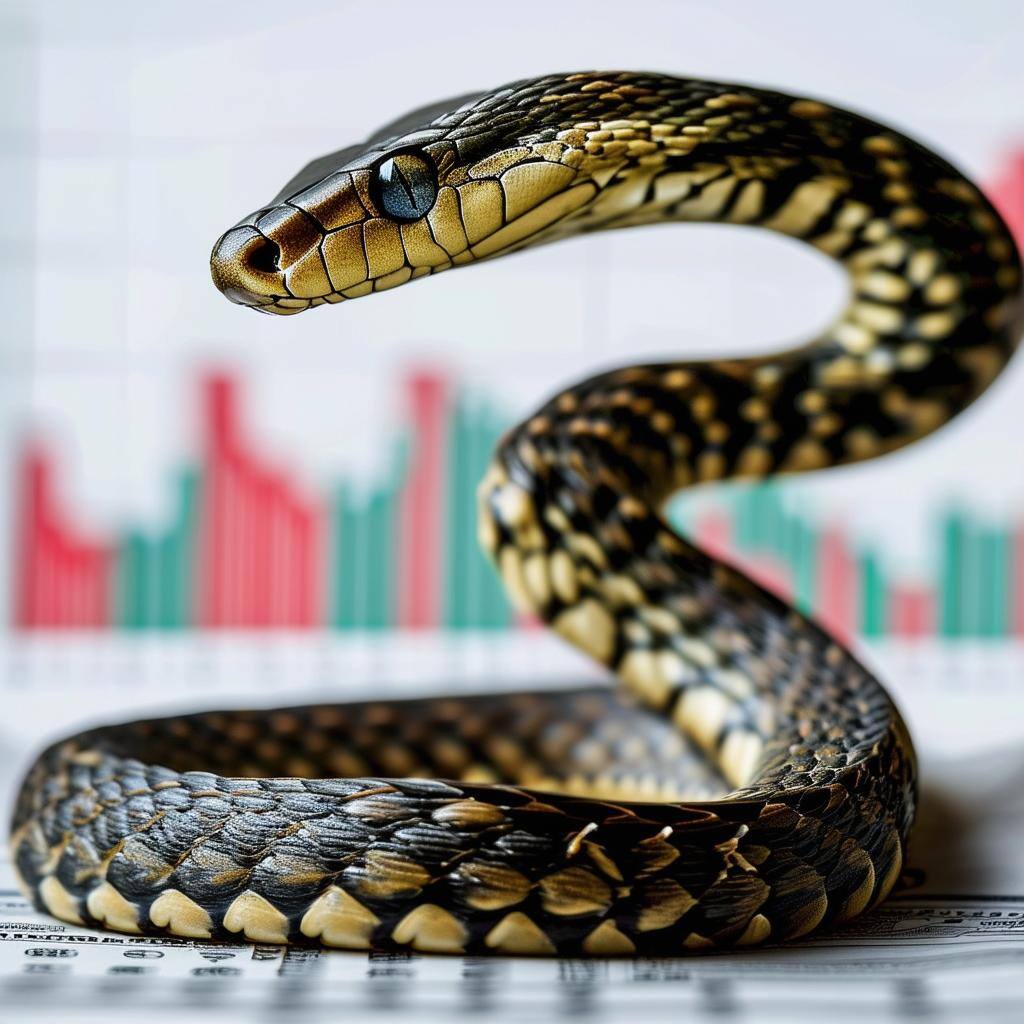
Meta and Microsoft crushed earnings, Tesla struggled, and tariffs are now real. Is this a turning point?
Meh. Not even a week ago, I sat down with Bloomberg Radio’s Carol Massar and Tim Stenovec (you can listen to the interview HERE) to discuss all things market. Before we went on air, we started to talk about all the conflicting market drivers that were flying around. This, as veteran radioman and all-around great guy Charlie Pellett ran through the markets on the other side of the studio. We collectively thought, with all this tape tumult, why is the VIX so tame? As we were chatting, Tim looked over at me and nodded to the microphone as I saw Carol’s mic light up. We were live!
We jumped right into it and continued the discussion. The VIX index is a measure of S&P500 volatility, but it is often called “The Fear Index,” because of the way in which it is calculated causing it to mostly trade in the opposite direction of the world’s favorite index, the S&P500. I noted that given all the uncertainty at the time—remember this was just a week ago—that the VIX was surprisingly low at around 14 at the time. Earnings season had just begun, and the Financial sector announced a great Q4 which added to earnings optimism. Wildcard Netflix was the first uber-growth stock to announce earnings a week earlier and it literally knocked the ball out of the park. Also, a positive signal for earnings yet to come. Materials and Industrials up until last Friday had underwhelmed, but all in all, earnings looked fairly decent. I think I said something like, “S&P earnings grew by 16% over last year with an average EPS beat of around 8%.”
However, we were approaching the precipice of Tech earnings, Mag-7 reports, more Senate confirmation hearings, a still undefined tariff policy, a still undefined immigration policy, etc. We knew that the week ahead—THIS WEEK—we were going get some more clarity on all those, and we certainly did.
Through this morning, on average, the S&P500 announcers beat by an average of around 6% with a year over year earnings growth of 8.4%. If you were paying attention above, you would note that the stats weakened somewhat in the past week. That may not be surprising given the week’s earnings announcement lineup. This past week, we had a number of Industrials which are not known to be big earnings growers. To date, Industrials missed by an average of around 2.5% with a year over year earnings decline of almost 9%.
Through this morning, we had 31 announcements from the Technology sector, in which there were only four EPS misses. The beats, not surprisingly, were somewhat close, as the bar is high for such a highly valued sector. The Communication sector delivered 5 big announcements which included Meta, of Mag-7 royalty, and that sector really came in with some strong beats; the bar is low for some of the other players in the sector, namely the Telecom giants.
Interesting sidenote: many companies which we consider “tech” companies are not in the Technology sector. For example, Alphabet and Meta are in the communications sector, which is dominated by Telcos, while Amazon is in the Consumer Discretionary sector—interesting considering that while it is a retail giant, most of its growth comes from its cloud computing/hyperscaler businesses. Keep that in mind.
Now, to date, Technology, which is about 1/3 done, beat earnings by 2.8% on average with a year over year growth of 11.5%, while Communications beat earnings estimates by 12.84% on average with an annual growth of 31.8%—every announcement beat EPS estimates to date. Communications, to date, displayed the biggest earnings growth of all sectors, climbing by 31.4% over Q4 of last year. Guess which players brough the average up? Never mind, I will just tell you. Netflix’s home run announcement delivered a 102.4% jump, and Meta grew earnings by 50.5%! Tech’s biggest outlier winner was Seagate which grew by 1591% while Intel’s 75.9% decline was the sector’s biggest loser.
Now, let’s get our heads out of the sector weeds and look at everyone’s favorite-to-discuss group, the Magnificent-7; I know that I am guilty of being obsessed with the group as well. My reason for this obsession is that Mag-7 performance really represents the market’s 2024 animal spirit, so tracking the group is a good way of checking that pulse of that spirit. Now, remember we are still talking about Q4 earnings from last year, the year in which the group’s stock performance came in at 67.3% —not too shabby.
Now, in this past week we got the first 4 of the 7 magnificent stocks that make up the group: Microsoft, Meta, Tesla, and Apple. Year over year earnings growth for those came in at 10.24%, 50.47%, 2.82%, and 10.09%, respectively. Meta delivered the biggest beat, and Tesla missed its mark with a miss.
Microsoft came in with a rounding-error-sized miss in its cloud business, which received a negative response from investors, despite its overall solid beat and growth. In fairness the weaker growth expected this quarter is due to Microsoft’s challenges getting capacity online—strong demand. And besides, Azure AI services are still expected to grow by 157%. That negative market response is not surprising, given the high expectations set for all things AI and cloud computing. But still, how can you scoff at growth like that? Microsoft, despite this, is a solid, quality grower, and 10% is good growth number for a company of that size number.
Meta came in with a solid revenue and EPS beat. With its aforementioned earnings growth, the company’s announcement which featured a slightly lower-than-expected current quarter guidance, and a great deal of confidence by CEO Mark Zuckerberg, delighted investors. Zuck thinks ’25 “will be a “really big year" for AI with expectations of reaching 1 billion subscribers with it.
Tesla missed EPS and revenue estimates. Despite this, CEO and DOGE Emperor Elon Musk kept nervous investors at bay with hype of an “epic” year… NEXT year, which would be followed by a “ridiculously good” ’27 and ’28. All due to Tesla’s long-awaited Robo-taxi launch which is scheduled to begin service later this year. Investors liked it, while analysts—most analysts—bit their fingernails.
Apple, which announced earnings last night, beat EPS and Revenue estimates within its typical margins. Investors were holding their collective breath waiting for news of smartphone sales in China, which were soft a quarter earlier; they were soft in Q4 as well. The softness however was attributed to inventory issues, not demand, which drew a collective exhale. iPhone sales are always top of mind for investors, and the companies modest beat was offset by an upbeat AI forecast and an expected “low- to mid-single digit” sales growth this quarter, gave investors what they needed to carry on.
So, collectively the first movers of the Mag-7 proved that all expectation bars are not created equal. CEO-hype and confidence is important, for some more than others, but important for all, nonetheless. Though that is not a new thing, its importance grows as ACTUAL earnings growth slows. 😉Overall, I would say that the first of the Mag-7 did not overwhelm, but neither did they underwhelm—it was a solid showing with a really high bar to negotiate. That is likely what we can expect from the remainder of announcements in broader tech, as well as the additional two Mag-7 members we will hear from next week, Alphabet and Amazon. We will have to wait until the end of the month to hear from AI posterchild NVIDIA, which will give investors time to cool down after this past weeks DeepSeek drama.
Now, on to yesterday’s GDP release. GDP came in at 2.3% missing estimates and declining from Q3. Consumptions, my favorite aggregate (because it represents 2/3 of GDP) came in strong, which is unquestionably positive. The decline was largely due to the Private Inventories category. This is an odd category which measures the changes in inventories. If inventories are growing, it means that companies may have produced beyond what is demanded, and vice versa for a decline. The Q4 decline can be viewed as positive and negative. Positive in that companies are not bloated with unsold merchandise, but negative in that there is potential for lower supply to cause prices to rise (can you say “pandemic”). All in all, yesterday’s print showed an expected slowing of growth, but shows a picture of a healthy economy.
This morning’s PCE Price Index came in as expected showing a slight pickup in annual inflation, with the core metric remaining unchanged. That would not be considered positive, but it would be in line with the Fed’s expectations, which are kind of important given that it is in charge of interest rate policy. Earlier this week, the Fed kept rates unchanged, which was largely expected. The message the Fed wanted investors to walk away with was “no more rate cuts until we see progress… and until we find out what all this new Trump policy actually is”. Speaking on that, we got a data point from President yesterday when he confirmed that 25% tariffs on Canada and Mexico would kick in tomorrow.
The market’s initial response was negative, but ultimately, stocks recovered when the President clarified that the tariffs may not cover all product classes. That eased fears that the Administration would levy taxes on oil and metals, which are sizable imports. However, details are still unclear, though investors are hoping that the tariffs will be measured and directed… and not include avocados. 🥑🤣
SO, to sum it all up. Earnings are still solid, the Mag-7 got off to a good-ish start, tariff policy is still just noise, immigration policy is starting to become clear with no direct impact on the markets yet, the economy is still healthy, and inflation is still sticky.
And the VIX index? Well, I referred to it as a coiled snake waiting to strike in my discussion with Tim and Carol. When the VIX spends long periods of time in the low-teens or single digits, despite market ambiguity, it could mean that investors are complacent and might react harshly to negative stimuli—like the huge one we got on Monday with DeepSeek, the upstart Chinese company that came out with a cheaper version of OpenAI’s and Google’s AIs. The snake did indeed strike with the VIX quickly spiking above 20 on Monday. But no worries, it is back almost to where it was during my interview. This may be a sign that markets have already factored in worst-case scenarios; if those scenarios are not exceeded, we should be good, but if they are… beware of those coiled snakes, their bites could be painful.
YESTERDAY’S MARKETS
Stocks had a bumpy ride, closing in the green in response to earnings and tariff talk from President Trump. GDP missed estimates and slowed from a quarter earlier—investors weren’t phased.

NEXT UP
- Core PCE Price Index (December) came in as expected at 2.8%, same as a month earlier.
- Personal Spending (December) grew by 0.7%, beating estimates, and above the prior month's 0.6% revision.
- Personal Income (December) came in as expected increasing by 0.4% after increasing by 0.3% in November.
- Next week: more earnings, in addition to PMIs, JOLTS Job Openings, Factory Orders, Durable Goods Orders, University of Michigan Sentiment, and the monthly employment numbers (main act). Check in on Monday for your weekly economic and earnings calendars.
.png)

